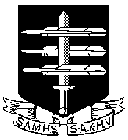

 The South African
The South African
Curtain raiser given by Mrs Roslyn Peter
to the Johannesburg branch of the MHS on
Thursday 8th November 2007
The battle occurred on 13th December 1939 off South America. It involved the German
surface raider Graf Spee and the Royal Navy's Ajax, Exeter and Achilles.
The primary aim of Captain Hans Landsdorf of the Graf Spee was to sink Allied merchant
ships. In two and a half months he sank nine in all, without any loss of life. Merchant
crewmen who were taken aboard as prisoners agreed that Landsdorf was a great gentleman
whom they respected. They told of how he would welcome them aboard, salute them and then
apologise for having had to sink their ships.
The three British vessels under the command of Commander Harwood were hunting Graf
Spee and Harwood guessed correctly that he would find the raider off Montevideo. During the
battle, Exeter was badly damaged and headed for the Falklands for repairs. Ajax
and Achilles were also taking a pounding, when Graf Spee broke off the engagement
heading westwards and into the port of Montevideo. The first thing Landsdorf did was to release
the prisoners. He would remark to one of them, pointing out to the horizon where the
Ajax and the Achilles were shadowing up and down, "How I regret that I will
have to engage them in battle again, I would rather shake their hands and congratulate them
on how well they had battled against me."
Harwood had been surprised, as Graf Spee did not appear to be badly damaged. But
Landsdorf was low on ammunition and supplies and in need of some repairs.
Landsdorf and the German Legation in Montevideo were trapped into believing that three
Royal Navy capital ships would be putting in to Buenos Aires just across the river estuary for
refuelling, the British hoping that this would force Graf Spee to be interned for the
duration of the war. Believing that he could not escape, Landsdorf requested orders from the
High Command in Berlin. Hitler's reply was that under no circumstances was he to intern the
ship in the neutral port.
On the morning of the 17th, it became clear that the Graf Spee was preparing to sail.
Later that afternoon, she made her way slowly out of the port, then the air was ripped with
[a] huge explosion as columns of smoke rose, followed by more smaller explosions. Graf
Spee had been scuttled. Landsdorf escaped with his crew by tugs to Buenos Aires where he
saw to the safe internment of his crew. After reporting to the German Embassy, he gathered his
crew and told them why he had made the decision to scuttle. "Rather 1 000 live young men, than
1 000 dead young heroes." His actions were not well received by Hitler.
Landsdorf then write three letters, one to his wife, his parents and the German Ambassador
explaining his actions. He ended all three with these words: "No captain with any sense of
duty and honour can separate his fate from that of his ship."
Then in his room he placed the battle ensign from the Graf Spee on the floor, lay down
and shot himself. The news saddened the British crews and the former prisoners. As with the
burial of the 42 crew from the Graf Spee two days earlier in Montevideo, a wreath with
the words "To the brave German Captain" was sent by the British for Landsdorf's funeral.
Forty years later survivors from the Graf Spee, Ajax, Exeter, Achilles
and former merchant prisoners sailed into Montevideo. They visited the graves of the 42
Graf Spee crew and the three Royal Navy crew buried there after the famous battle,
and then crossed the estuary to Buenos Aires and to the grave of Hans Landsdorf. There, the
crew of Graf Spee sang the traditional German naval lament for a fallen comrade; this
was followed by a bugler playing the Last Post, and two representatives from all the vessels
plus merchant POWs held a wreath laying ceremony.
That Landsdorf's own crew would return to pay tribute to their Captain is understandable, but
that his enemy would do so as well leaves us with the question, "What manner of man was
this man Hans Landsdorf?"
Naval historians agree, he was a man who could not bridge the gap between peace and war.
He was first and foremost a sailor, a man who honoured life above all else. His actions clearly
show this, he spared the lives of his crew and paid with his own. Hitler and the Reich did not
acknowledge him as a hero, rather the opposite.
The Second World War produced more villains than any other war, but in this epic there are
no villains, only heroes.
Captain Hand Landsdorf of the German Surface raider was in true international naval
tradition, an officer and a gentleman.
Return to Society's Home page
South African Military History Society / scribe@samilitaryhistory.org